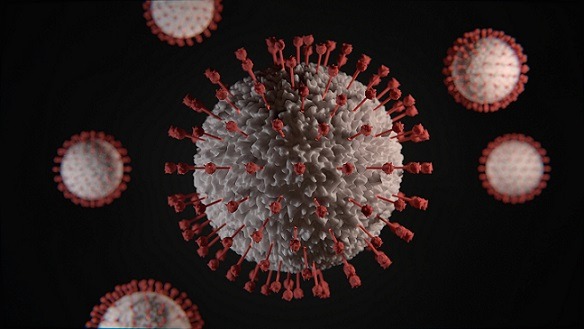The B.1.617 variant that has caused the recent COVID-19 crisis in India has been implicated in increased transmission of the disease among the population and poses a significant challenge with respect to disease severity and effectiveness of currently available vaccines.
COVID-19 has caused unprecedented damage in the entire world both socially and economically. Certain countries have witnessed the second and third waves as well. There has been a recent increase in the number of cases in India which has now witnessed an average of three to four hundred thousand cases every day for the past month or so. We recently analysed what may have gone wrong with the COVID crisis in India1. Besides the social and cultural factors that may have led to the upsurge, the virus itself has mutated in such a manner which has led to the emergence of a variant that is more infectious than before. This article describes about the how the new variant might have emerged, its disease causing potential and implications for vaccine effectiveness and what steps can be taken going forward to reduce its impact locally and globally and prevent further emergence of novel variants.
B.1.617 variant first appeared in October 2020 in the state of Maharashtra and has since spread to about 40 nations, including the United Kingdom, Fiji and Singapore. Over the past few months, the strain has become a dominant strain all over India and especially in the last 4-6 weeks has been responsible for a huge increase in infection rates. The B.1.617 has eight mutations of which 3 mutations namely L452R, E484Q and P681R are the key ones. Both L452R and E484Q are in the Receptor Binding Domain (RBD) and are responsible not only for increase binding to ACE2 receptor2 resulting in increased transmissibility, but also play a role in antibody neutralization3. The P681R mutation significantly augments syncytium formation, that potentially contributes to increased pathogenesis. This mutation causes viral cells to fuse together, creating a larger space for the virus to replicate and making it difficult for the antibodies to destroy them. In addition to B.1.617, two other strains may have also been responsible for the rise in infection rates, B.1.1.7 in Delhi and Punjab and B.1.618 in West Bengal. The B.1.1.7 strain was first identified in the UK in second half of 2020 and bears the N501Y mutation in RBD, that led to its increased transmissibility by enhanced binding to ACE2 receptor4. In addition, it has other mutations, including two deletions. B.1.1.7 has so far spread globally and has acquired the E484R mutation in UK and the USA. It has been shown that the E484R mutant has 6-fold decrease in sensitivity to immune sera from individuals vaccinated with the Pfizer’s mRNA vaccine and an 11-fold decrease in sensitivity to convalescent sera5.
The new strain of virus with added mutations can only emerge when the virus infects the hosts and undergoes replication. This leads to the generation of more “fitter” and infectious variants. This could have been avoided by preventing human transmission by adhering to safety protocols such as social distancing, appropriate use of masks in public/crowded places and following basic personal hygiene guidelines. The emergence and spread of B.1.617 suggest that these safety guidelines may not have been followed strictly.
The B.1.617 strain that has created havoc in India, has been classified by the World Health Organisation (WHO) as the “variant of concern (VOC)”. This classification is based on increased transmissibility and spread of severe disease by the variant.
The B.1.617 strain has been shown to cause stronger inflammation in animal studies using hamsters than any other variants6. In addition, this variant entered by increased efficiency in cell lines in vitro and did not bind to Bamlanivimab, an antibody used for COVID-19 treatment7. Studies by Gupta and colleagues have shown that although neutralizing antibodies generated by the individuals vaccinated using Pfizer’s vaccine, were about 80% less potent against some of the mutations in B.1.617, this would not render vaccination ineffective3. These researchers also found that some health-care workers in Delhi who had been vaccinated with Covishield (Oxford–AstraZeneca vaccine), had become reinfected, with the B.1.617 strain. Additional studies by Stefan Pohlmann and colleagues7 using serum from people who had previously been infected with SARS-CoV-2, found that their antibodies neutralized B.1.617 about 50% less effectively than previously circulating strains. When serum was tested from participants who’d had two shots of the Pfizer vaccine, it revealed that the antibodies were about 67% less potent against B.1.617.
Although above studies indicate that the B.1.617 has an advantage over the other strains of the virus in terms of higher transmissibility and evading neutralizing antibodies to a certain extent based on serum-based antibody studies, the real situation in the body may be different due to the huge number of antibodies produced and also that other parts of the immune system such as T cells may not be affected by the strain mutations. This has been shown by the B.1.351 variant which has been linked to huge drop in the potency of neutralizing antibodies, but human studies indicate that the vaccines are still effective in preventing severe disease. Moreover, studies using Covaxin also showed this vaccine continues to be effective8, although there had been a small drop in the effectiveness of neutralizing antibodies generated by the Covaxin vaccine.
All of the above data suggests that more research is required to understand the effectiveness of the current vaccines and generation of future versions based on the emergence of the new strains that may try and evade the immune system for their own advantage. Nevertheless, the current vaccines continue to be effective (albeit may not be 100%), so as to prevent severe disease and the world should strive for mass vaccination at the earliest possible and simultaneously keeping an eye on the emerging strains in order to take necessary and appropriate action at the earliest. This would ensure that the life can return back to normalcy sooner rather than later.
***
References:
- Soni R. 2021. COVID-19 Crisis in India: What May Have Gone Wrong. Scientific European. Posted on 4 May 2021. Available online at https://www.scientificeuropean.co.uk/covid-19/covid-19-crisis-in-india-what-may-have-gone-wrong/
- Cherian S et al. 2021. Convergent evolution of SARS-CoV-2 spike mutations, L452R, E484Q and P681R, in the second wave of COVID-19 in Maharashtra, India. Preprint at bioRxiv. Posted May 03, 2021. DOI: https://doi.org/10.1101/2021.04.22.440932
- Ferreira I., Datir R., et al 2021. SARS-CoV-2 B.1.617 emergence and sensitivity to vaccine-elicited antibodies. Preprint. BioRxiv. Posted May 09, 2021. DOI: https://www.biorxiv.org/content/10.1101/2021.05.08.443253v1
- Gupta R K. 2021. Will SARS-CoV-2 variants of concern affect the promise of vaccines?. Nat Rev Immunol. Published: 29 April 2021. DOI: https://doi.org/10.1038/s41577-021-00556-5
- Collier D A et al. 2021. Sensitivity of SARS-CoV-2 B.1.1.7 to mRNA vaccine-elicited antibodies. Nature https://doi.org/10.1038/s41586-021-03412-7.
- Yadav P D et al. 2021. SARS CoV-2 variant B.1.617.1 is highly pathogenic in hamsters than B.1 variant. Preprint at bioRxiv. Posted May 05, 2021. DOI: https://doi.org/10.1101/2021.05.05.442760
- Hoffmann M et al. 2021. SARS-CoV-2 variant B.1.617 is resistant to Bamlanivimab and evades antibodies induced by infection and vaccination. Posted May 05, 2021. Preprint at bioRxiv. DOI: https://doi.org/10.1101/2021.05.04.442663
- Yadav P D et al. 2021. Neutralization of variant under investigation B.1.617 with sera of BBV152 vaccinees. Published: 07 May 2021. Clin. Infect. Dis. DOI: https://doi.org/10.1093/cid/ciab411
***




































